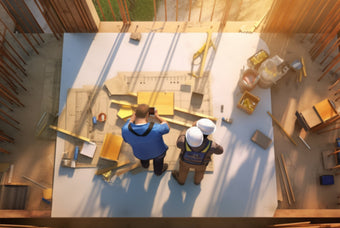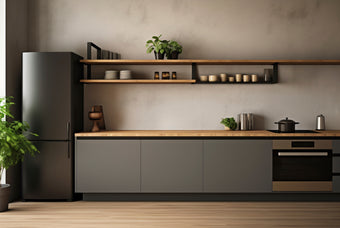Most popular
Are you considering new flooring for your home but unsure which type to choose and where to get it from? Look no further than GlobalFair. In this blog, we will explore the differences between glue down and click LVT options, helping you make an informed decision that suits your needs and style and we have a variety of collections you could choose from.
Glue-down LVT (Luxury Vinyl Tile) is a popular choice for its durability and stability. This type of flooring is directly adhered to the subfloor using adhesive, creating a seamless and permanent installation. It is a versatile option that works well in high-traffic areas and provides excellent resistance to moisture and wear.
On the other hand, click LVT offers a hassle-free installation process. With a click-locking system, the planks or tiles can be easily snapped together, eliminating the need for adhesive. This option is ideal for DIY enthusiasts or those looking for a quick and convenient flooring solution.
So, whether you prioritize long-lasting durability or easy installation, we will guide you through the features and benefits of glue down and click LVT options. By the end of this article, you will have the knowledge and confidence to choose the perfect flooring for your home.
Understanding Glue Down LVT
Glue-down LVT (Luxury Vinyl Tile) is a popular choice for its durability and stability. This type of flooring is directly adhered to the subfloor using adhesive, creating a seamless and permanent installation. It is a versatile option that works well in high-traffic areas and provides excellent resistance to moisture and wear. One of the key advantages of glue-down LVT is its long-lasting durability. Since it is securely glued to the subfloor, it creates a stable surface that can withstand heavy foot traffic and everyday wear and tear. This makes it an ideal choice for busy households, commercial spaces, and areas prone to moisture, such as kitchens and bathrooms.

In addition to its durability, glue-down LVT offers a wide range of design options. From natural stone and wood textures to modern patterns and vibrant colors, there is a plethora of choices available to suit various interior styles and preferences. This allows homeowners to achieve the desired aesthetic without compromising on performance. Another benefit of glue-down LVT is its superior moisture resistance. The adhesive used during installation creates a watertight bond, preventing moisture from seeping through the seams. This makes it an excellent choice for areas where water spills or high humidity levels are common, as it helps to protect the subfloor from damage.
However, it's important to note that glue-down LVT installation requires careful preparation and professional expertise. The subfloor needs to be clean, level, and moisture-free before the adhesive can be applied. This can add to the overall cost and time required for installation. Additionally, the permanent nature of the glue-down method means that replacing damaged tiles or planks can be challenging and may require professional assistance.
Pros and Cons of Glue Down LVT
Pros:
-
Superior durability and stability
-
Wide range of design options
-
Excellent resistance to moisture and wear
Cons:
-
Requires professional installation expertise
-
The cost and time of installation can be higher
-
Replacing damaged tiles or planks can be challenging
Exploring Click LVT
On the other hand, click LVT offers a hassle-free installation process. With a click-locking system, the planks or tiles can be easily snapped together, eliminating the need for adhesive. This option is ideal for DIY enthusiasts or those looking for a quick and convenient flooring solution. Click LVT is designed with interlocking edges that fit together like puzzle pieces. This allows for a straightforward installation process that can be accomplished by homeowners with basic DIY skills. The click system ensures a secure and stable connection between the planks or tiles, creating a durable flooring surface. One of the major advantages of click LVT is its ease of installation. Since it does not require adhesive, the process is faster and less messy compared to gluing down LVT. Homeowners can save time and effort by opting for click LVT, especially if they are looking for a quick flooring makeover.

In addition to its easy installation, click LVT offers versatility in terms of removal and reinstallation. Unlike glue-down LVT, click LVT can be easily disassembled and reused, making it a convenient choice for those who may want to change their flooring in the future. This flexibility allows homeowners to update their interiors without the need for extensive renovation. However, it's important to consider the limitations of click LVT. While it offers convenience and flexibility, it may not be as suitable for high-traffic areas or spaces prone to moisture. The interlocking edges, although secure, may not provide the same level of stability as glue-down LVT. Therefore, it is important to assess the specific requirements of your space before choosing to click LVT.
Pros and Cons of Click LVT
Pros:
-
Easy and hassle-free installation process
-
Versatile and removable for future updates
-
Suitable for DIY enthusiasts
Cons:
-
May not offer the same level of durability as glue-down LVT
-
Limited suitability for high-traffic areas or moisture-prone spaces
-
Interlocking edges may require extra care during installation
Factors to Consider When Choosing Between Glue Down and Click LVT
When deciding between glue-down and click LVT options, there are several factors to consider. These include the specific needs of your space, your budget, installation preferences, and long-term plans for your flooring. Firstly, assess the level of durability required for your space. If you have a busy household or commercial area with high foot traffic, glue-down LVT may be the better choice due to its superior stability and resistance to wear. On the other hand, if you are looking for a temporary flooring solution or have a low-traffic area, click LVT may be a more suitable option.

Secondly, consider your budget and installation preferences. Glue-down LVT may involve additional costs for professional installation and adhesive materials. If you are on a tight budget or prefer a DIY project, click LVT can offer cost savings and a straightforward installation process. Lastly, think about your long-term plans for your flooring. If you anticipate the need for future updates or changes to your interior, click LVT provides the flexibility to disassemble and reuse the flooring. On the other hand, if you are looking for a permanent and long-lasting flooring solution, glue-down LVT offers stability and durability. Consider these factors carefully to determine which type of LVT flooring aligns with your specific needs and preferences.
Installation Process for Glue Down LVT
The installation process for glue-down LVT requires careful preparation and professional expertise. Here are the general steps involved:- Prepare the subfloor: Ensure the subfloor is clean, level, and free from moisture. Remove any existing flooring or debris to create a smooth surface.
- Apply adhesive: Use a recommended adhesive suitable for LVT flooring. Follow the manufacturer's instructions for proper application and coverage.
- Install the LVT: Begin laying the LVT tiles or planks, starting from one corner of the room. Press each piece firmly into the adhesive, ensuring proper alignment and tight seams.
- Trim and finish: Use a utility knife or appropriate cutting tool to trim the LVT to fit around edges, corners, and obstacles. Once the installation is complete, allow the adhesive to cure according to the manufacturer's instructions.
It is important to note that the specific installation process may vary depending on the brand and type of glue-down LVT. Always refer to the manufacturer's guidelines for detailed instructions.
Installation Process for Click LVT
The installation process for click LVT is relatively simple and can be accomplished by homeowners with basic DIY skills. Here are the general steps involved:- Prepare the subfloor: Ensure the subfloor is clean, level, and free from moisture. Remove any existing flooring or debris to create a smooth surface.
- Acclimate the LVT: Allow the LVT planks or tiles to acclimate to the room's temperature and humidity as per the manufacturer's recommendations.
- Lay the underlayment: Install a suitable underlayment according to the manufacturer's guidelines. This helps to provide additional cushioning and noise reduction.
- Begin installation: Start from one corner of the room and lay the first plank or tile. Align the interlocking edges with the previous piece and press down firmly to secure the connection. Continue this process throughout the room, ensuring tight seams and proper alignment.
- Trim and finish: Use a utility knife or appropriate cutting tool to trim the LVT to fit around edges, corners, and obstacles. Once the installation is complete, ensure all edges are secure and the flooring is properly aligned.
Always refer to the manufacturer's instructions for specific installation guidelines as they may vary depending on the brand and type of click LVT.
Maintenance and Care Tips for Glue Down and Click LVT
Both glue-down and click LVT require regular maintenance to ensure their longevity and performance. Here are some general maintenance and care tips:- Clean regularly: Sweep or vacuum the LVT flooring regularly to remove dirt, dust, and debris. Use a damp mop or recommended LVT cleaner to remove stains or spills.
- Use protective pads: Place felt or rubber pads under furniture legs to prevent scratches or indentations on the LVT surface.
- Avoid excessive moisture: While LVT is resistant to moisture, it is still important to clean up spills promptly and avoid excessive moisture buildup. Use mats or rugs in areas prone to water spills, such as kitchens or bathrooms.
- Trim pet nails: If you have pets, ensure their nails are properly trimmed to prevent scratches on the LVT surface.
- Follow manufacturer's guidelines: Always refer to the manufacturer's guidelines for specific maintenance instructions and recommended cleaning products.
By following these maintenance and care tips, you can keep your glue down or click LVT flooring looking its best for years to come.
Conclusion: Making the Best Choice for Your Flooring Needs
When it comes to choosing the perfect flooring, understanding the differences between glue down and click LVT options is crucial. Glue-down LVT offers superior durability, stability, and moisture resistance, making it an excellent choice for high-traffic areas and spaces prone to moisture. On the other hand, click LVT provides easy installation, versatility, and the flexibility to disassemble and reuse the flooring.
Consider factors such as durability requirements, budget, installation preferences, and long-term plans for your flooring to make the best choice. Whether you opt for the permanent and stable nature of glue-down LVT or the convenience and versatility of click LVT, both options offer excellent performance and a wide range of design possibilities.
By following the installation, maintenance, and care tips provided, you can ensure the longevity and beauty of your LVT flooring. So, take your time, assess your needs, and make an informed decision that will enhance your home's aesthetics and functionality.
Discover top-tier flooring at GlobalFair. Explore our flooring options now!
Empty content. Please select category to preview
Join our newsletter now
Promotions, new products and sales. Directly to your inbox.





